Sample Technology Infused Sample Lesson Plan - 3
F Razo - DATE: April 25, 2008
SUBJECT: – Science: Grade Four - Electrical Currents Creating Magnetism and Mechanical Motion
INSTRUCTIONAL GOAL: Students should be able to understand the effect of electrical currents in creating magnetism, mechanical movement, and how this is used for practical applications.
Grade Four Science Content Standards
Physical Sciences
Investigation and Experimentation
Electricity and magnetism are related effects that have many useful applications in everyday life. As a basis for understanding this concept:
- Students know how to design and build simple series and parallel circuits by using components such as wires, batteries, and bulbs.
- Students know how to build a simple compass and use it to detect magnetic effects, including Earth's magnetic field.
- Students know electric currents produce magnetic fields and know how to build a simple electromagnet.
- Students know the role of electromagnets in the construction of electric motors, electric generators, and simple devices, such as doorbells and earphones.
- Students know electrically charged objects attract or repel each other.
- Students know that magnets have two poles (north and south) and that like poles repel each other while unlike poles attract each other.
- Students know electrical energy can be converted to heat, light, and motion.
I. CONCEPT TO BE DEVELOPED : What is an electromagnet, how does it work, and how it is useful.
II. LIST OF OBJECTIVES :
Concepts to be developed:
2.- A wire wound up in loops (coil) can create a stronger magnetic field.
2.- A piece of iron-metal inserted inside the coil would concentrate its magnetism to have even stronger magnetic effects.
3.- The core inside the coil of an electromagnet can be used to attract other iron-metal pieces, and used for a variety of practical purposes.
Additional concepts that are important to expansion :
- The electrically controlled mechanical action of electromagnets is useful in practical applications of remote controls for automation.
III. LIST OF MATERIALS NEEDED: (preferably one whole set per student)
- A common drinking straw
- A 5-inch long iron nail - to fit inside the straw
- Five feet of slim electrical wire (e.g. AG18)
- One 6V flashlight battery
- A common hiking magnetic compass
- A metal (iron) paper clip
- Miscellaneous household and industrial electrical actuators to be analyzed in class
Safety precautions and / or special procedures:
Students should be warned that during the activities, the two wires connecting to the battery should not be held in contact at the same time for longer time than just the brief touch specified in the experiment. Possible wire overheating and burn to the fingers could occur otherwise
IV - THE LEARNING CYCLE
A. INTRODUCTION:
QUESTIONS FOR THE STUDENTS:
Do you ever wonder how you can push a button-switch and make:
- A bell ring inside a house?
- A door or gate open, close, or get locked?
- A machine, such as a vacuum cleaner, a copier, or a car begin to move?
- The temperature control in a house start the air conditioner when is hot?
- The Mars Rover (explain, if needed) controls its wheels to turn?
Can you design and build a device of the kind that can makes those things happen?
TEACHER-GUIDED INTRODUCTION:
Students are told that an electrical battery is an reservoir of electrical energy, ready to provide it to any electricity-conducting device, specifically metal wires (normally copper or gold) providing a closed/returning path (circuit) from one of the battery poles, through to the other.
When the electricity flows through conducting wires, a flow of electrons goes "waving" through the wire, creating a magnetic "halo" around it called a "magnetic field". This magnetic field behaves the same as a common magnet.
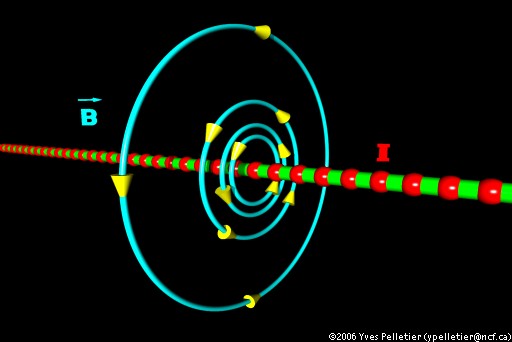
To collect magnetism from a wire and make the field stronger, the wire is looped multiple times in a "coil".
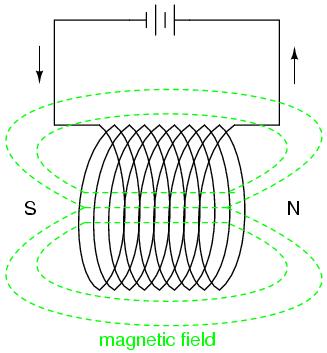
To concentrate the magnetism from the coil even further, an iron piece can be inserted in the middle of the coil. This piece is called the "core", and it becomes a magnet that can be activated when we turn the electricity on and off in the wire. The device created is called an "electromagnet".
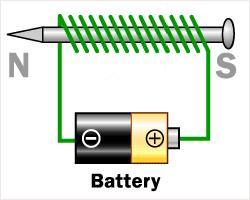
An interactive Internet simulation activity is available from this link to illustrate how electricity provided by a battery can be used to activate an electromagnet, which magnetizes and can push a core (loose nail) inside of it. The simulation also includes an activity to illustrate how reversing the active role of (shaking) a permanent magnet inside a coiled wire can be used to generate electricity.
When electromagnets are used to pull or push the core into mechanisms to control them, the electromagnets are sometimes called "solenoids".
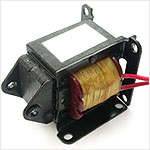 |
Solenoid |
B. EXPLORATION PHASE: (students will do)
1.- To see that a wire creates a magnetic field, the thin wire is coiled over the straw. Coiling should include some 200 loops (turns), and the two ends of the wire should be left available to connect to the battery contacts. One end can be tied permanently (butterfly twist), and the other let loose for ONLY instantaneous contact-and-release touch-switching operation.
A common compass should be now placed near the end of the coil, to detect magnetism from the coil. The loose end of the wire should then be made to touch briefly (a half of a second or less "pulsing") the second (free) contact of the battery.
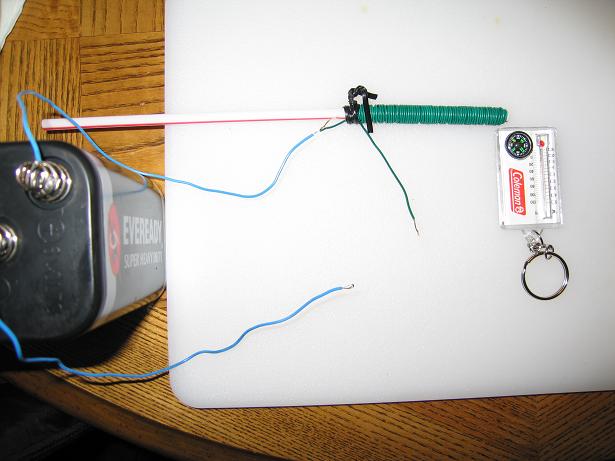
QUESTIONS: WHAT HAPPENS TO THE COMPASS NEEDLE EVERY TIME ELECTRICITY IS PULSED INTO THE COIL? WHY?
2.- To create an electromagnet, the iron nail (core) should now be inserted in the straw inside the coil. The effects of the increased magnetism over the compass due to the added core can be observed, by pulsing of electricity into the coil.
 |
Electromagnet core |
QUESTIONS: IS THE EFFECT DIFFERENT WHEN THE CORE IS ADDED TO THE COIL? WHY?
3.- To show the mechanical ability of the electromagnet, the compass should be removed, and a common metal paper clip placed in front of the core (about a half-inch away). The effect can now be observed, by pulsing of electricity into the coil.

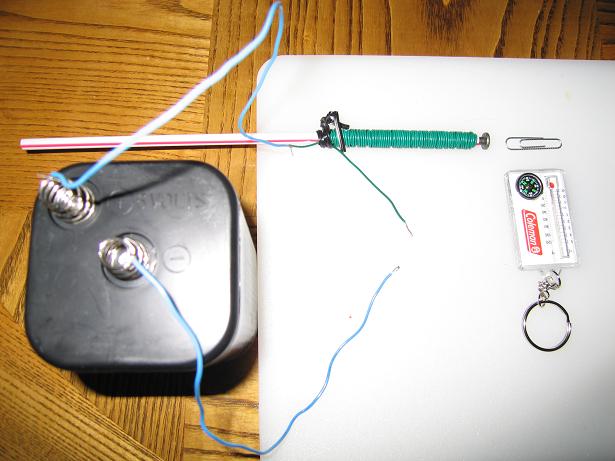 |
|
Electromagnet |
|
QUESTIONS: WHAT HAPPENS TO THE PAPER CLIP WHEN ELECTRICITY IS PULSED INTO THE COIL? WHY?
Exploratory activity:
QUESTIONS: HOW WOULD THE ELECTROMAGNETY BEHAVE (COMPASS & PAPER CLIP) IF WE INCREASE THE POWER OF THE BATTERIES (MORE CURRENT INTO THE COIL)? WHY?
WHAT WOULD HAPPEN TO THE NAIL ITSELF, IF IT WAS LOOSE AND SLIPPERY INSIDE THE COIL, AND THE ELECTROMAGNET WAS VERY STRONG ?
C. CONCEPT DEVELOPMENT:
Key questions and desired answers:
QUESTION: WHAT WAS INSIDE THE BATTERY, AND HOW IT ENDED UP PULLING THE PAPER CLIP? Ans: (Chemical) Electrical energy, converted to magnetic energy by the wire, and converted to mechanical energy by the core-magnet.
Each student should be able to recount the process of conversion of energy, from the battery, to the wire, to the core, to the paper clip. If any confusion persists, focus on the specific step of the exploration and redo, individually, or as a group.
QUESTION: WHAT IS DIFFERENT ABOUT AN ELECTROMAGNET, AS COMPARED WITH A PERMANENT MAGNET?
D. APPLICATION PHASE:
ASSIGNMENT 1 : Students search all available sources (Internet included: Google, e.g. "practical applications of electromagnets") to find out at least 20 different practical applications of electromagnets. Each student writes the descriptions of findings in a report.
ASSIGNMENT 2 : Students can try combining TWO batteries, and then pulsing the electromagnet using the new arrangement to observe possible new behaviors. (The teacher should explain the two possible ways and supply effects of combining the two batteries: parallel, and series. Parallel can make the same current be sustained longer, while series can make the current flow more intense, but sustained for a shorter time).
QUESTION: WHAT IS DIFFERENT WHEN DIFFERENT BATTERY ARRANGEMENTS ARE USED TO DRIVE ELECTROMAGNETS?
ASSIGNMENT 3 : Students will be asked:
QUESTION A : WHAT IF WE REPLACE THE CORE FOR A LARGE, HEAVY, FIXED, SINGLE PIECE PERMANENT MAGNET, WHILE MAKING THE COIL THINER, LIGHTER, AND LOOSE. ---> WHO WOULD THEN BE MOVING WHEN ELECTRICITY IS PULSED?
At discussion time, the students can be hinted about the workings of sound speakers, earphones, and asked to search encyclopedias and the Internet for descriptions and pictures showing the structure of these devices. (AS AVAILABLE, SAMPLE OF DISSECTED ITEMS CAN BE SHOWN IN THE CLASSROOM).
| ELECTRICITY (Sound & Music signals) - IN -> |
 |
OUT -> MECHANICAL FORCE (Vibrations to the air) |
The students can be then hinted about the workings of spinning electrical generators, and asked to search encyclopedias and the Internet for descriptions and pictures showing the structure of these devices, and refer to the alternative sources of "spinning power" available in nature (water streams, ocean, wind, geothermal, sun, etc.), or through man made resources (boiling water, burning fuels, nuclear reactions, etc.) AS AVAILABLE, SHOW SMALL SAMPLES IN THE CLASSROOM - MS Encarta has a nice multimedia animation of an electrical generator.
| MECHANICAL FORCE - IN -> |
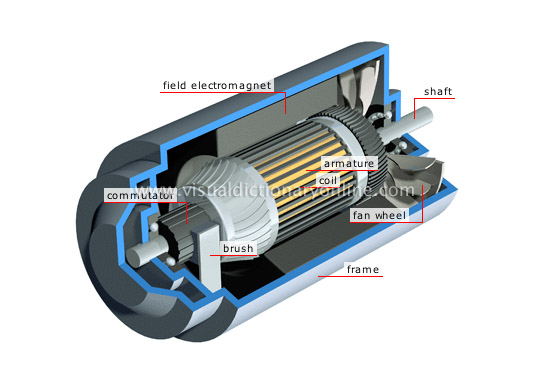 |
OUT -> ELECTRICITY |
QUESTION: WHAT IF WE REVERSE THE LOCATION OF THE CORE AND COIL, SO AS TO HAVE THE COIL WRAPPED AROUND A CENTER AXLE PIECE INSIDE A LARGE PERMANENT MAGNET TUBE. REPLACE THE PELLET AND CORE FOR A STRONG, SINGLE PIECE HEAVY PERMANENT MAGNET. WHO WOULD THEN MOVE (SPIN) WHEN ELECTRICITY IS PULSED INTO THE (CENTER) COIL?
The students can be hinted about the workings of spinning (synchronous) electrical motors, and asked to search encyclopedias and the Internet for descriptions and pictures showing the structure of these devices - AS AVAILABLE, SHOW SMALL SAMPLE IN THE CLASSROOM - MS Encarta has a nice multimedia animation of an electrical motor.
| ELECTRICITY - IN -> |
 |
OUT -> MECHANICAL FORCE |
E. PROBLEM FINDING:
QUESTION: CAN YOU THINK OF ANY OTHER POSSIBLE APPLICATION OF THE COMBINATION AND TRANSFORMATION OF ELECTRICAL INTO MAGNETIC AND MECHANICAL ENERGY? - The students can be hinted about miniaturization, and the different natural forces being sought for the extraction of energy: biomass, ocean currents, deep earth probes, etc.
V. EVALUATION:
Have the students describe, in their own words, one paragraph and one sketch picture per item:
- What is the first thing needed to extract electricity from a battery you have? - a conducting/metal wire
- How can wires create stronger magnetism? - by winding them into coils with many loops
- How can the magnetism from a coil be concentrated for even stronger effects? - using metal cores
- How can magnetism from coils (electromagnetism) be used to activate/move mechanical devices? - by using independent, movable pieces that are attracted/repelled by magnetism
- Please list FIVE different, practical applications of electromagnets
REFERENCES:
Use Google to search for the topic: Electromagnets
http://www.themagnetguide.com/electro-magnets.html




